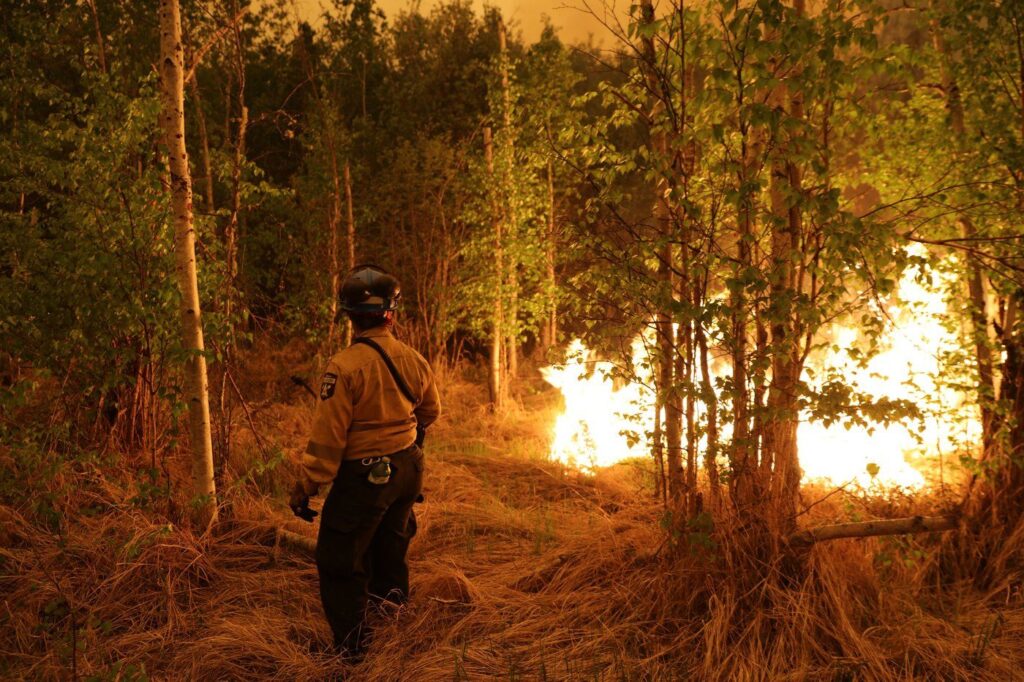
Features
Aerial Firefighting
Public safety
Alberta eyes greater reliance on wildfire technology
April 10, 2024 By George Lee, Local Journalism Initiative Reporter, The Macleod Gazette
 Wildland firefighters will be safer on the job because of technology, says Forestry and Parks Minister Todd Loewen.
Photo courtesy Alberta (Photo: Ministry of Forestry and Parks)
Wildland firefighters will be safer on the job because of technology, says Forestry and Parks Minister Todd Loewen.
Photo courtesy Alberta (Photo: Ministry of Forestry and Parks) What if you showed up for an Alberta wildfire and your water source was frozen over?
That was just one of the many challenges crews faced last year in a long, arduous and record-breaking season that burned a combined area the size of Prince Edward Island – times four.
Todd Loewen, the minister of forestry and lands, said an internal review followed the unprecedented season. Among its recommendations are more use of high-tech support like night vision and thermal imaging.
Effective wildland firefighting overnight is key to Alberta doing a more effective job, the member for Central Peace-Notley said. Fires tend to settle down at night because of cooler, sometimes humid conditions.
The overarching goal is keeping communities, their residents and firefighters as safe as possible in 2024, Loewen said.
On May 6 last year, the province declared a state of emergency that continued for a month. More than 38,000 people in 48 Alberta communities were displaced by evacuation orders in 2023. In all, the province recorded 1,088 wildfires in a season that saw 2.2-million hectares ravaged by flames, an area 10 times the five-year average.
The province called upon 4,038 individuals from Alberta, the rest of Canada and around the world to fight wildfires. Alberta’s total personnel numbered about 1,700 plus 300 contractors. Wildland firefighters that the government employs for ground crews made up about 800 of its total personnel, Loewen said.
Loewen witnessed the situation up-close. “Because we had so many fires close to my home, I had the chance to go out at four o’clock on multiple mornings in a row to multiple different fires and see them firsthand,” he said.
The experience convinced him that more night firefighting is a viable approach. “There’s always been the concern of fighting fires at night because of safety issues, but with the technology we have now, like towing in light plants and bringing in water with all-terrain vehicles, we can have a full-fledged fire-fighting team working at night.”
Although conditions tend to make suppression at night more effective, crews may be at risk without advanced night-vision technology from eyes in the sky in supporting helicopters.
High-tech drones equipped with thermal imaging are used to map, monitor and evaluate wildfires. This helps the province prepare for the next morning, so the crews deployed then are more prepared and effective.
Although the province’s website says there were no wildfires of significance as of Feb. 16, they have become a year-round phenomenon. Sometimes when crews and equipment arrive, especially in the north, lakes aren’t ready to cooperate.
There’s no way to skim an iced-over lake with planes or dip buckets into them from helicopters. “We were somewhat restricted right from the start,” Loewen said.
What to do? For one, pump water from where ice has melted along shorelines into large, standing bags for helicopters to dip their buckets into. Water can even be drawn from muskeg tracts or trucked in to fill bags.
Capital investments – the purchase of hard assets like machines and equipment – are in the plans for 2024-2025, the province’s budget tabled Feb. 29 says. To support wildfire fighting, $55 million will go towards facilities and equipment including a fleet of air tankers. And the government has begun the process of replacing the air tanker fleet completely with one that “can better address the province’s current and emerging needs,” Budget 2024 documents said.
Over three years, $151 million is earmarked for enhancements to the Wildfire Management Program, to improve response readiness and night operations, support volunteer and community response programs, and provide more airtanker support and other resources.
All the tech talk doesn’t convince NDP forestry critic Heather Sweet. “Technology should never replace boots on the ground when it comes to the safety of our communities and first responders,” she told the Local Journalism Initiative.
“Fighting fires at night is high-risk due to debris, such as fallen trees and unstable ground, which could be covered up. A drone cannot detect these hazards. The government is trying to save money at the expense of first-responder safety,” said Sweet, the member for Edmonton-Manning.
The province started the wildfire season early, which automatically activates fire restrictions in the Alberta Forest Protection Area. In the budget, it earmarks money for 100 more wildland firefighters.
The budget adds $2 billion to a contingency fund, recognizing $1.5 billion in withdrawals last year during fire season. Loewen’s ministry will see operating expenses for forests, parks and lands go up $52 million to $351 million in 2024-2025, or 17.4 per cent higher than forecast in 2023-24.
Those numbers don’t start from actual costs in 2023. Expenses for forestry alone last year are estimated at over $1 billion – a 2023-24 budget line more than five times what had been projected. The Alberta Emergency Management Agency, meanwhile, will have spent about $400 million in the final reckoning for 2023-24, almost four times last year’s budget projection.
Sweet said the province hasn’t recovered from its own cuts to personnel and spending, dating from 2020.
“The government does not want to actually address the issue,” she said. “They will respond in a time of crisis. But putting any investment into prevention is not on this government’s agenda. And it is a failure, because communities and Albertans deserve better from the government when the indications are that this is going to be a massive wildfire season.”